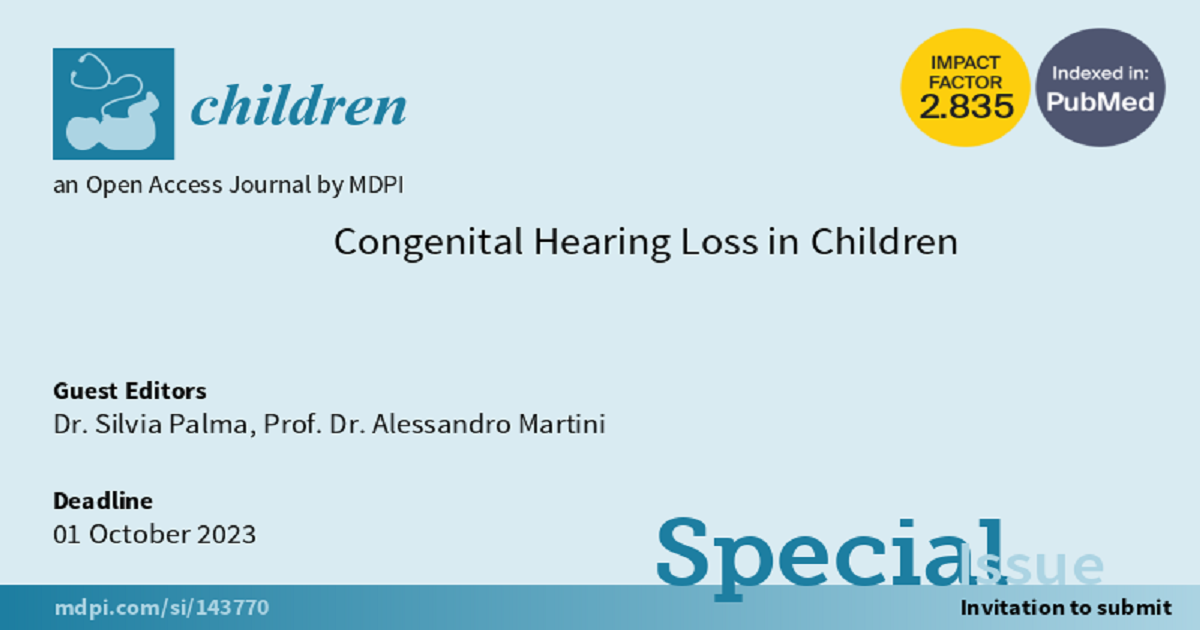Congenital Hearing Loss in Children
A special issue of Children (ISSN 2227-9067). This special issue belongs to the section "Pediatric Otolaryngology".
Deadline for manuscript submissions: closed (5 July 2024) | Viewed by 8376

Special Issue Editors
Interests: cytomegalovirus infection; congenital hearing loss; communication skills in toddlers; middle ear diseases
Special Issues, Collections and Topics in MDPI journals
Interests: hearing disorders; otology; cochlear implants; audiology; genetics
Special Issues, Collections and Topics in MDPI journals
Special Issue Information
Dear Colleagues,
Hearing loss is one of the most frequent congenital diseases in children. It has a reported prevalence of 1–3:1000 in “healthy babies” and a major prevalence, with variable results, in the neonatal intensive care unit population. As underlined by a recent WHO report, hearing loss, if unaddressed, can negatively impact many aspects of life, particularly language and speech development in children.
Implementing an ever-greater understanding of the prevalence and underlying mechanisms of sensorineural hearing loss improves the clinical decision-making prognosis and treatment of these conditions. Early diagnosis and medical intervention have been shown to lead to improved developmental outcomes. In addition, hearing technology, such as hearing aids and cochlear implants, is effective and can benefit children.
[*] Cutting-edge research: In developed countries, it has been reported that up to 80% of congenital hearing loss is due to genetic causes, with the remaining 20% being secondary to environmental or acquired causes.
We are soliciting papers focused on implementing knowledge in the field, particularly the prevalence of acquired hearing loss cases: for example, from “TORCH” infection (toxoplasmosis, syphilis, rubella, cytomegalovirus, and herpes) or postnatal bacterial meningitis.
Dr. Silvia Palma
Prof. Dr. Alessandro Martini
Guest Editors
Manuscript Submission Information
Manuscripts should be submitted online at www.mdpi.com by registering and logging in to this website. Once you are registered, click here to go to the submission form. Manuscripts can be submitted until the deadline. All submissions that pass pre-check are peer-reviewed. Accepted papers will be published continuously in the journal (as soon as accepted) and will be listed together on the special issue website. Research articles, review articles as well as short communications are invited. For planned papers, a title and short abstract (about 100 words) can be sent to the Editorial Office for announcement on this website.
Submitted manuscripts should not have been published previously, nor be under consideration for publication elsewhere (except conference proceedings papers). All manuscripts are thoroughly refereed through a single-blind peer-review process. A guide for authors and other relevant information for submission of manuscripts is available on the Instructions for Authors page. Children is an international peer-reviewed open access monthly journal published by MDPI.
Please visit the Instructions for Authors page before submitting a manuscript. The Article Processing Charge (APC) for publication in this open access journal is 2400 CHF (Swiss Francs). Submitted papers should be well formatted and use good English. Authors may use MDPI's English editing service prior to publication or during author revisions.
Keywords
- congenital hearing loss
- syndromes, genetics
- epidemiology, cytomegalovirus
- newborn hearing screening
- infection
Benefits of Publishing in a Special Issue
- Ease of navigation: Grouping papers by topic helps scholars navigate broad scope journals more efficiently.
- Greater discoverability: Special Issues support the reach and impact of scientific research. Articles in Special Issues are more discoverable and cited more frequently.
- Expansion of research network: Special Issues facilitate connections among authors, fostering scientific collaborations.
- External promotion: Articles in Special Issues are often promoted through the journal's social media, increasing their visibility.
- e-Book format: Special Issues with more than 10 articles can be published as dedicated e-books, ensuring wide and rapid dissemination.
Further information on MDPI's Special Issue policies can be found here.







